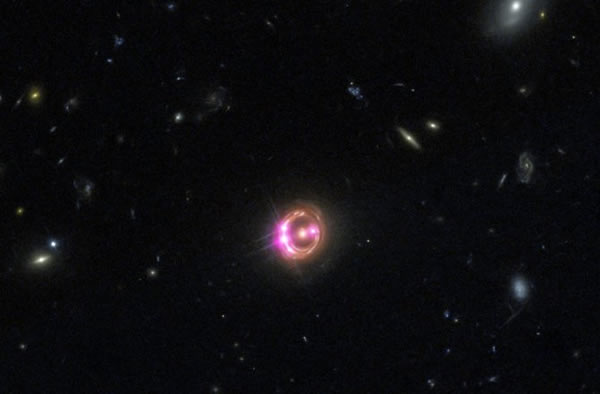Distant Black Hole Spins at Half the Speed of Light
Multiple images of a distant quasar are visible in this combined view from NASA’s Chandra X-ray Observatory and the Hubble Space Telescope.
Back when the universe was half its present age, supermassive black holes were feeding from a steady and plentiful diet of neighboring galaxies, the first measurement of a distant supermassive black hole’s spin shows.
Taking advantage of a naturally occurring zoom lens in space, astronomers analyzed X-rays streaming from near the mouth of a supermassive black hole powering a quasar about 6 billion light years from Earth.
“The ‘lens’ galaxy acts like a natural telescope, magnifying the light from the faraway quasar,” University of Michigan astronomer Rubens Reis explains in a paper published in this week’s Nature.
Analyzing four magnified images created by the lens galaxy -- an elliptical galaxy about 3 billion light years away -- Reis and colleagues found that the quasar’s black hole is spinning at half the speed of light.
The spin rate directly relates to how black holes feed and grow: The steadier the diet, the faster the spin, computer models show.
“If the mass accretion was more messy it would suggest that the black hole would have a lower spin,” astronomer Mark Reynolds, also with University of Michigan, told Discovery News.
“What we found in this system is that it’s spinning very rapidly,” Reynolds said, consuming mass equivalent to about one sun per year.
That suggests that the quasar, known as RX J1131-1231, is growing primarily by what is known as “coherent accretion” such as what might happen when two galaxies merge, producing lots of gas that can funnel down toward the black hole very efficiently, Reynolds said.
Until astronomers measure the spin rates of other and even more distant supermassive black holes they won’t know if RX J1131 is an odd bird or not.
“This is the first time that we’ve been able to push out to this type of distance by using the gravitational lensing effect. We hope ... to carry out similar studies on other (more distant) galaxies. Then we can begin to really start relating the black hole to the actual galaxy it’s in, how many mergers happened and things like that,” Reynolds said.
Spin rates may evolve over time, reflecting changes in evolution of galaxies.
“Different theories of galaxy evolution predict a different rate of mergers, and a different process of gas inflow into the center of galaxies,” Guido Risaliti, with the INAF Arcetri Astrophysical Observatory in Florence, Italy, wrote in an email to Discovery News.
“These processes, in turn, determine the final black hole spin. So knowing the distribution of supermassive black hole spins is a way to constrain the way they were formed, and so, ultimately, the way their host galaxies formed and evolved,” Risaliti wrote.
At some distance, the black holes’ spins might be even higher, approaching light speed, and then slow down to RX J1131’s spin rate.
“If we go back further, maybe they’ll all be maximally spinning because of more mergers and more things happening. Or maybe they’ll be less spinning. We can theoretically produce both scenarios at the moment,” Reynolds said.(Mar 5, 2014 01:00 PM ET // by Irene Klotz)












